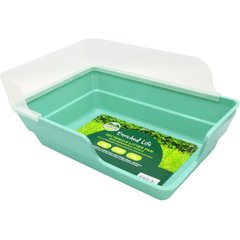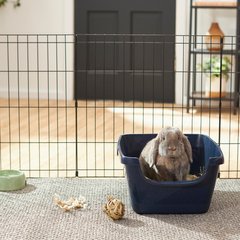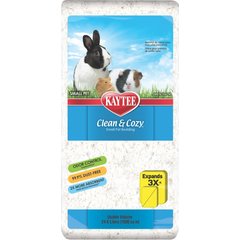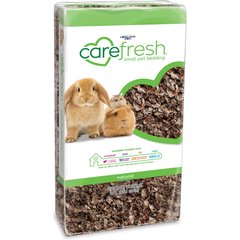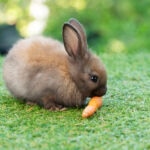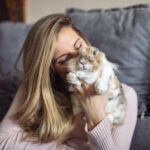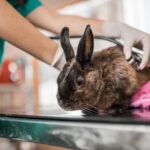Rabbit Poop Guide: What Your Bunny’s Poop Means
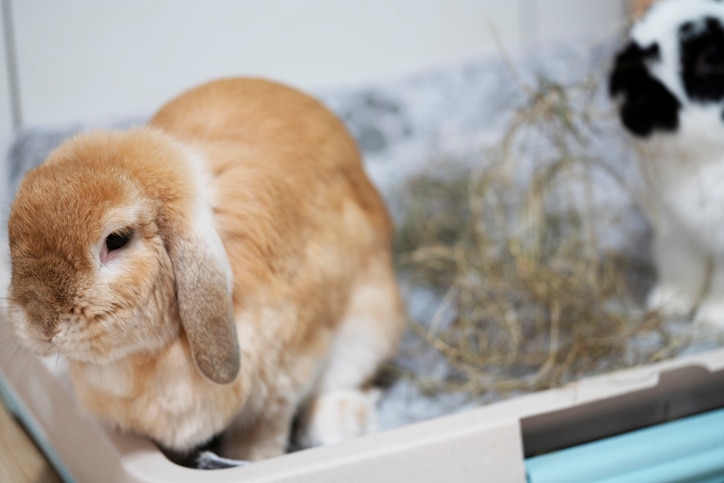
Photo by Alice Wanwarameth / iStock / Getty Images Plus
Poop is more than just waste—understanding rabbit stools is key to monitoring your bunny’s health.
Here’s everything you need to know about rabbit poop: what’s normal, what’s not, and what to do if you think something’s off with your rabbit’s poop.
What Is Rabbit Poop and Why Is It Important?
To wrap your head around the importance of rabbit poop, you first must understand rabbits and how they’re different from other mammals.
Rabbits are herbivorous hindgut fermenters.
“[This] is a fancy way of saying that their diet consists of mostly dry plant material that is actually digested in their large intestine (specifically their cecum) instead of their stomach, like most other mammals,” says Colleen Roman, DVM, RVT, exotic animal veterinarian and board member of the Association of Exotic Mammal Veterinarians. Horses, guinea pigs, and chinchillas also fall into this category.
The small amounts of nutrients in their food are absorbed in the stomach and small intestine. What’s left moves to the colon, where it’s separated into large, indigestible particles and smaller particles that are broken down by the “good” bacteria in the cecum (the first part of the large intestine).
Because of this, rabbits produce two distinct types of stools: fecal pellets and cecotropes, says Alisa Rassin, VMD, founder and medical director of Exotic & Small Animal Hospital of Pennsylvania.
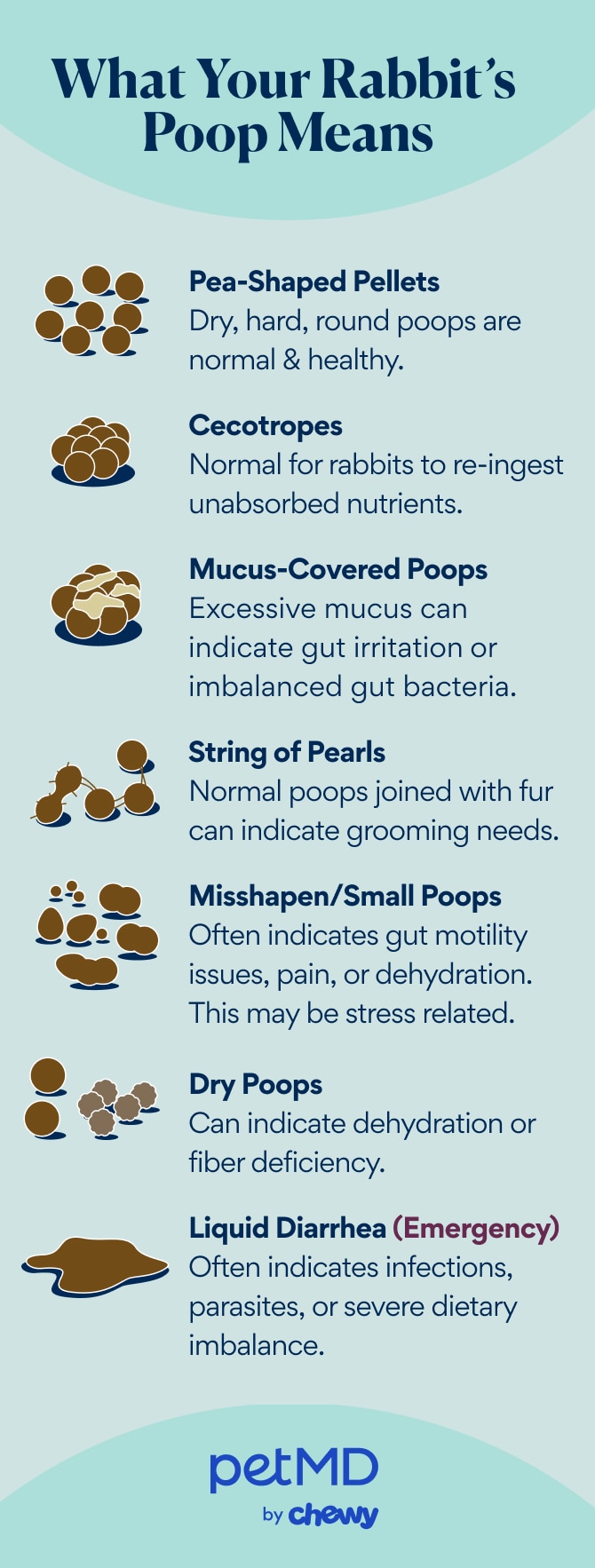
Photo by Chewy
Types of Rabbit Poop
There are several different types of rabbit poop, some of which are normal and others that signal it’s time to call your vet.
Here’s a rabbit poop guide that highlights the most common types of stools you may see in your rabbit’s litter box and what they might mean for your bunny’s health.
Recommended Products
Fecal Pellets
Fecal pellets are made from the indigestible particles in the colon. They’re packed down and expelled as dry, hard, round pieces.
The smaller particles pass into the large intestine, where they’re fermented by the bacteria that live there. As this fermentation occurs, the bacteria release proteins, vitamins, and fatty acids that are packed together to form softer, mucus-coated pellets. These are called cecotropes, or “night feces,” although they can happen at any time of the day.
Cecotropes
Cecotropes come out in clusters of small, round pellets. They’re typically ingested as they exit the anus, as they are extremely nutrient-packed and essential for the rabbit’s health, according to Dr. Roman.
“Think of cecotropes as the rabbit’s own natural probiotic, containing good bacteria, proteins, nitrogen, vitamins, and minerals,” she says. “Rabbits eating stool may sound disgusting, but it is necessary to keep their digestive tract happy and healthy.”
String of Pearls
“String of pearls” describes normal fecal pellets that are stuck (or strung) together with fur. This is often seen during shedding season, which occurs in the spring and fall.
While not necessarily an immediate issue, this usually means your rabbit is ingesting excess fur, which can increase the risk of gastrointestinal (GI) issues. You might want to give your rabbit more greens to help them move things along.
Egg-Shaped Rabbit Poop
Misshapen, oval stool might suggest reduced gut motility or underlying health issues, such as pain or dehydration, according to Dr. Rassin. This is not common and should be evaluated by a vet.
Double and Single Rabbit Poop
Doubles and singles mean your rabbit is pooping some individual pellets and some that are fused together.
Fused or doubled pellets occur when gut motility slows, causing pellets to form improperly. This can be an early sign of digestive issues, according to Dr. Rassin. Any digestive issues in rabbits should be taken seriously—a small problem can become life-threatening quickly.
Diarrhea
True liquid diarrhea is rare and always an emergency. This is often caused by bacterial infections, parasites, or severe dietary imbalances.
If your rabbit has diarrhea, take them to the vet ASAP.
Small Rabbit Poops
Small rabbit poop is a sign of reduced gut movement. This is commonly caused by stress but can also be a result of pain, dehydration, illness, or eating less.
If your rabbit’s poop is smaller than normal, reach out to your vet.
Misshapen Rabbit Poops
Misshapen rabbit poops are a sign of inconsistent gut motility, the muscular contractions that move food through the digestive tract. This is commonly due to stress, illness, or diet.
Dry Rabbit Poops
Dry rabbit poop is usually caused by dehydration or insufficient dietary fiber.
Healthy fresh poop falls apart when you apply pressure to it. If your rabbit’s fresh poop doesn’t fall apart, it might be too dry. Keep in mind that the longer bunny poop sits, the drier it gets, so you should test this with a fresh pellet.
While it’s generally safe for humans to handle rabbit poop, Dr. Roman says you should always practice safe hygiene and wash your hands after handling any feces, as there is still a potential risk of parasites and bacterial infection. And it goes without saying, but do not ingest rabbit stool.
Mucus-Covered Rabbit Poops
Cecotropes are often covered in a small amount of mucus, but if you see a lot, it can be because of gut irritation or an imbalance in gut bacteria.
Dr. Rassin says this is often linked to infections or severe dietary issues, so check with your vet if your bunny has mucus-covered poops.
What Does Healthy Rabbit Poop Look Like?
Rabbit stools are a critical indicator of your pet’s health, which is why Dr. Roman says that rabbit parents should always be aware of what their rabbit’s normal stool looks like.
So, what does rabbit poop look like in a healthy bunny? The following two types of stools are normal:
- Fecal pellets (round, firm, dry, and consistent in size)
- Cecotropes (soft, clustered, shiny, and dark brown to black in color)
What Does Unhealthy Rabbit Poop Look Like?
Unhealthy rabbit poop is basically any type of stool that doesn’t fall into the two “healthy poop” categories.
The actual appearance of unhealthy rabbit poop can vary widely, but some things you might see are:
- Lots of smaller dry pellets
- Large, misshapen pellets
- Fecal balls strung together
- Diarrhea
Dr. Rassin adds that a common pattern in sick rabbits is alternating dry fecal balls with larger soft fecal balls or diarrhea.
When To Call Your Vet About Your Rabbit’s Poop
Rabbits are a “prey species,” meaning it’s in their nature to hide any outward signs of illness, according to Dr. Roman.
“[Your] rabbit may look fine on the outside, but their stool will tell a different story of what is going on inside,” she says. And the earlier you can address potential issues, the more likely your vet will be able to help.
That said, Dr. Rassin recommends seeking immediate veterinary care if:
- Your rabbit stops producing stool entirely for longer than eight hours
- True diarrhea occurs (this comes with a risk of dehydration and infection)
- There is mucus or blood in the stool
If the following symptoms develop with changes in your rabbit’s stool, call an emergency vet:
- Lethargy
- Reduced appetite/not eating
- Weight loss
- Teeth grinding
- Difficulty urinating
- Hunched appearance
Ultimately, the most important thing is to know your rabbit’s normal habits and behavior. Any changes could be indicative of an underlying problem and should be addressed with a rabbit-savvy vet.
Rabbit Poop FAQs
Q: What should my rabbit’s poop look like?
A: Your rabbit’s poop should either be small, round, hard, dry fecal pellets or smaller, softer fecal pellets with a light mucus coating (cecotropes).
Q: When should I be concerned about my rabbit’s poop?
A: “Any changes in size, shape, or frequency can indicate early health issues. A high-fiber diet, proper hydration, and regular veterinary checkups are crucial for maintaining healthy gut function,” says Dr. Rassin.
Q: Can I put rabbit poop in my garden?
A: Yes, you can put rabbit poop in your garden.
“Rabbit fecal pellets make excellent fertilizer because they are rich in nitrogen and phosphorus and do not require composting before use. They break down slowly, providing a steady nutrient release to plants,” says Dr. Rassin.
Cecotropes, however, are softer and should be composted before application.
